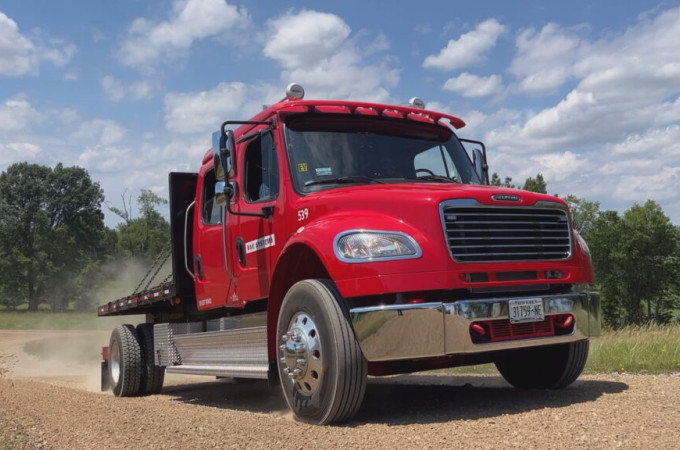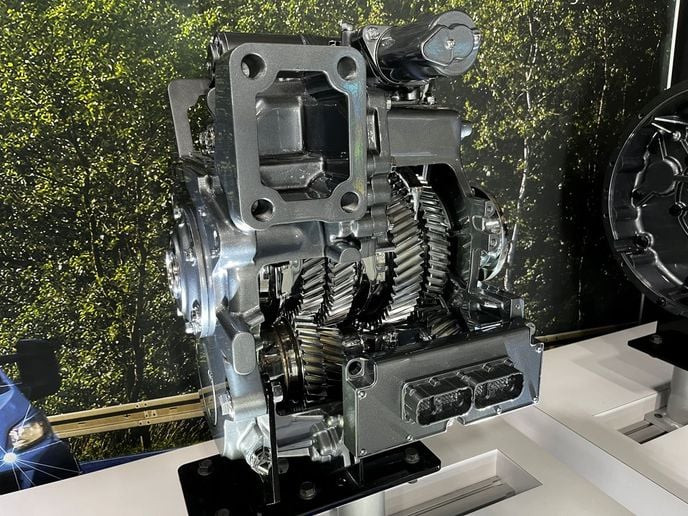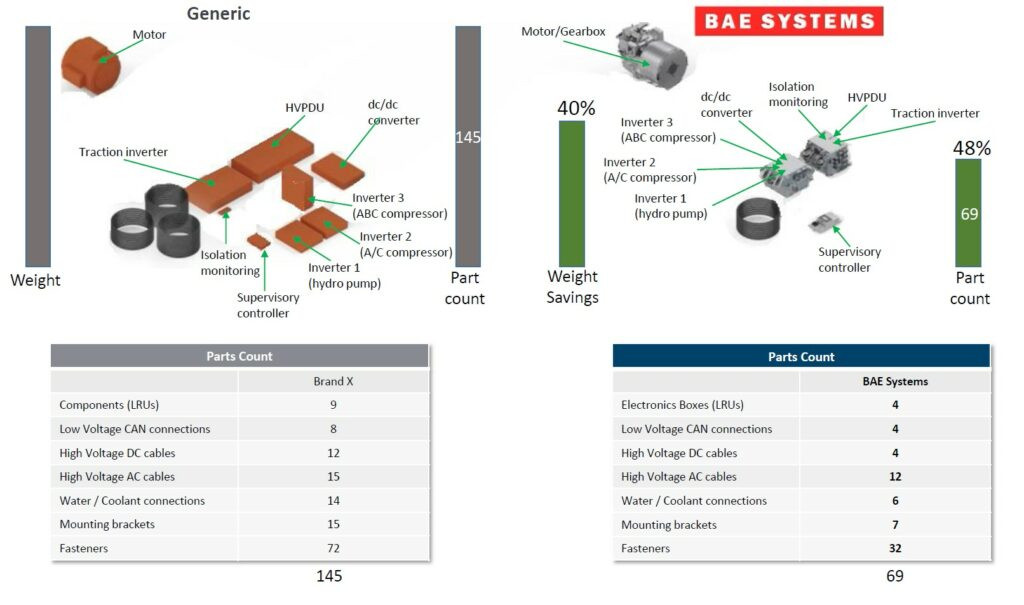BAE Systems and Eaton demonstrates electric drivetrain for the CV truck market at IAA
By Luke Willetts - 22nd October 2024

Freightliner demonstrator truck
Germany / USA — At the 2024 IAA event in Hanover (September 17 – 22), electric propulsion systems supplier, BAE Systems Inc. of Endicott, New York and transmissions specialist, Eaton Corporation of Maumee, Ohio, displayed their jointly developed electric drivetrain on the stand. The integrated electric drive system has already been tested on a Class 7 demonstration vehicle (a 2018 Freightliner M2 Class 7 chassis retrofitted with the electric motor, inverters and transmission) at Eaton’s proving grounds in Marshall, Michigan in June 2024. This electric drivetrain solution is the result of a collaboration that was first announced a year ago at ACT 2023, where the companies revealed plans to offer modular, scalable electric drivetrain solutions for the medium- and heavy-duty commercial truck market.
Why collaborate?
Both companies have significant experience in the electrification of commercial vehicles: BAE Systems has more than three decades of knowledge developing and integrating electric propulsion systems in battery electric, fuel cell, and hybrid electric vehicles (notably for more than 25 years in the heavy-duty transit industry) and Eaton has extensive expertise in manufacturing transmissions for many different transport and other applications. Consequently, leveraging both company’s core competencies was the major reason behind this collaboration, with BAE Systems bringing its expertise in electric propulsion system integration and power electronics and Eaton contributing its transmission expertise. Both companies see unaddressed market demand for a fully integrated electric drivetrain solution in the commercial vehicle sector.

Eaton's MD 4-speed automated manual EV transmission
The truck demonstrator and test results
According to Tom Webb, Director of Business Development and Strategy for the Power and Propulsion Solutions business at BAE Systems, the company’s move into offering a solution to the medium- and heavy-duty truck market is a logical step forward to harnessing its electric drive technology and experience in the transit bus market. The modified 2018 Freightliner M2 crew cab was stripped of its ICE powertrain and replaced with BAE Systems’ power-dense electric motor and advanced silicon carbide/gallium nitride power electronics suite together with Eaton’s medium-duty four-speed (MD4-speed) EV transmission. The vehicle features Forsee Zen 77 Plus batteries and a Meritor rear axle with a 3.9:1 ratio. Whilst the demonstrator model uses the newly developed powertrain, other chassis parts are standard across the industry. Webb said that this system can also be fitted with Eaton’s HD-4 EV heavy-duty transmission, offering electric drive systems for commercial trucks (19 tonnes and over).

Tom Webb, Director of Business Development and Strategy, Power and Propulsion Systems at BAE
As aforementioned, BAE Systems and Eaton Corporation have successfully tested their medium-duty (MD) electric vehicle (EV) truck powertrain solution, showcasing promising results. The system demonstrated strong performance during tests conducted on a Class 7 vehicle. Key achievements included meeting critical on-road goals such as gradeability and constant highway speeds because of the power to gear ratios, all within a compact, lightweight system that enhances electrical efficiency and vehicle weight reduction. The truck at 33,000lb gross vehicle weight (GVW) and 18,000 lbs (8 tonne) payload was able to scale a circa 25% grade whilst fully loaded during testing. BAE highlighted that this electrification solution gave rise to a curb-weight increase of just 1,400 lbs (0.62 tonnes) compared with the ICE equivalent.
Recording a top speed of 70 mph or 112 km/h (electronically limited), the demo truck doubled its acceleration rate (from 0-20 mph) (0-32 km/h) when compared to the ICE equivalent vehicle and its 0-50 mph (0-80 km/h) acceleration time was reduced by over 20 seconds. The system has impressive acceleration compared with diesel equivalents due to instant torque delivery, which is considered important for urban applications in optimising delivery schedules. Furthermore, the EV truck produces zero tailpipe emissions, making it ideal for cities with strict emissions regulations and contributing to the overall reduction of carbon footprint in freight transport. Operator cost savings will be seen over time, as the TCO is expected to be lower for electric trucks due to the combination of fuel savings and reduced maintenance costs, with significant savings projected over 5 to 10 years.
This integration aims to create a more efficient and effective EV powertrain for medium duty trucks in hilly terrain and heavy duty long haul trucks requiring high performance. Commenting on the partnership at the start of the relationship, Bob Lamanna, Vice President and General Manager of Power & Propulsion Solutions at BAE Systems said: “Our robust solution is built on proven technology to meet the unique demands of EV trucks. This integrated approach simplifies the complex electric drive system for trucks and commercial vehicles.” The partners state they plan to provide original equipment manufacturers with a durable, high-performance, compact, efficient, and optimised system with the flexibility to work with multiple zero-emission platforms.

Bob Lamanna, Vice President and General Manager of Power & Propulsion Solutions at BAE Systems
Benefits
A 4-speed transmission offers several advantages over direct drive, namely, allowing the motor to operate at its most efficient RPM range, and improving overall energy efficiency, especially at higher speeds. Secondly, the system allows for improved torque control as multiple gears provide greater torque at lower speeds, which is beneficial for towing, climbing hills, or carrying heavy loads. Enhanced acceleration becomes a factor as shifting gears can optimise power delivery, resulting in quicker, smoother acceleration compared to direct drive. Finally, the benefit of extended range. By optimising the motor's performance, a multi-speed transmission can help improve the driving range of electric HGVs, especially on highways. These benefits make 4-speed transmissions more suitable for heavy-duty EVs compared to direct drive systems, which are more common in simpler, lower-power applications.
Furthermore, according to Webb, a major benefit of the BAE Systems’ propulsion system, is the reduced number of components, cables and connections, which save space and weight. The design reduces the typical parts count versus a typical competitor’s solution from 145 to 69. The design architecture also simplifies the integration process whilst lowering overall cost. Reducing overall weight is still a major sticking point for battery electric HGVs. This becomes a nuanced issue, trying to reduce the weight of the vehicle whilst providing the requirements of the medium-duty transport industry in terms of power and performance.

BAE Systems parts comparison
Gauging the market for integrated e-drive and transmission solutions
The aim of having this drivetrain solution on display at the IAA was to gauge the marketability of this integrated technology in the medium-duty truck segment, model designs of which are similar in the urban logistics and delivery service sectors in Europe and North America.
During the IAA we spoke with Ian Wilson, Director of Business Development for Power & Propulsion Solutions at BAE Systems, he told us there is certainly growing market demand for integrated electric drive systems like those offered by BAE Systems and Eaton, driven by several factors, including the regulatory push for emissions reductions around the world. Electric drive systems help meet these regulations by offering zero-emission or low-emission solutions, making them increasingly attractive for commercial vehicles like trucks. These stricter emissions will continue to drive the adoption of clean transportation solutions in both the public and private sectors.
The integrated system displayed at the IAA offers a complete electric vehicle solution for a wide range of zero-emission platforms, which is attractive to manufacturers looking for turnkey options as the system is adaptable to various vehicle types, including pick-up and delivery trucks, school and transit buses, material handling, refuse, and regional haul trucks. Ultimately the success or failure will be determined by whether it is an effective solution that can be integrated efficiently, at cost and help offer long-term cost reductions for the operator. Wilson believes overall, the market for electric drive systems will expand rapidly in specific vehicle applications where environmental, economic, and regulatory pressures align, making the BAE Systems and Eaton partnership well-positioned to meet this demand.

Ian Wilson, Director of Business Development for Power & Propulsion Solutions at BAE Systems
Moving forward
Firstly, the details of the Memorandum of Understanding (MoU) signed between the two are as follows: The deal is a non-exclusive, co-marketing arrangement where each party can compete in the open market whilst collaborating in areas of mutual benefit. This project represents a step toward developing more sustainable commercial vehicle solutions. It's part of a broader trend in the transportation industry towards hybrid and electric vehicles, especially in response to stricter emissions regulations and increased demand for eco-friendly solutions.
Conclusion
The collaboration between the two companies aims to offer original equipment manufacturers (OEMs) a durable and efficient electric powertrain solution adaptable across various truck platforms. The products will be integrated but sold separately and directly to OEMs with spare parts being made available to customers by both companies. These developments position BAE Systems and Eaton to penetrate the medium and heavy-duty truck market, expanding their electric vehicle technology solutions beyond transit buses and into commercial trucks and related sectors. The companies expect to release details of their first customers before the end of the year.


